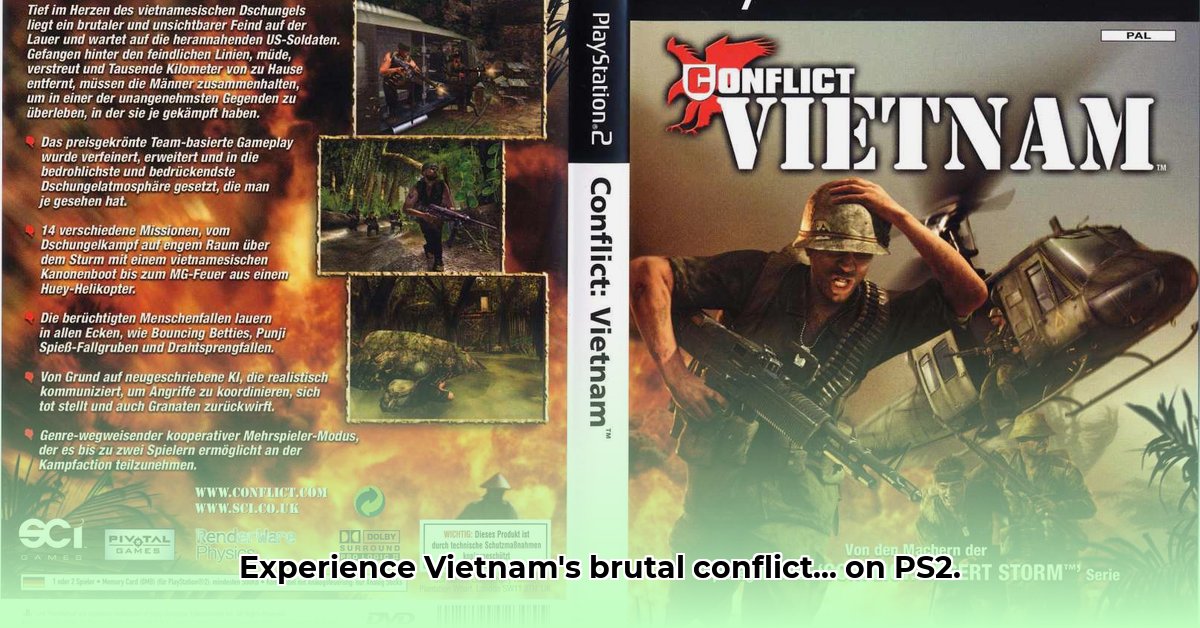
Gameplay and Mechanics: A Blast from the Past
Firing up a PlayStation 2 emulator and loading Conflict: Vietnam offers a unique retro gaming experience. While not a chart-topping title, its cooperative gameplay and Vietnam War setting have cultivated a dedicated following. The game's visuals haven't aged well, appearing quite dated by modern standards. However, its charm lies in its cooperative mode – a rarity in console shooters of the era. Teaming up to navigate jungles and fight presented a genuinely enjoyable experience, boosting replayability. The weaponry felt substantial, even if the variety wasn't vast. Compared to later, more complex tactical shooters, Conflict: Vietnam offered a simpler, more arcade-like experience. This simplicity contributes to its enduring appeal. But was this simplicity a strength or a weakness compared to its contemporaries? Let's delve deeper.
Historical Accuracy: Hollywood's Vietnam
How accurately does Conflict: Vietnam portray the Vietnam War? The game attempts realism with relatively accurate weaponry, but it undeniably simplifies a complex conflict. It's more akin to a Hollywood action movie set during the war than a historical document. The narrative takes liberties, glossing over complexities to focus on action. Expect generalizations and occasional inaccuracies; it's not a substitute for a history book. Its portrayal reflects the broader cultural understanding of the Vietnam War prevalent in the early 2000s. What are the ethical implications of using a complex historical event for entertainment purposes, especially when the interpretation is arguably simplified?
Reception and Legacy: A Quiet Success
Comprehensive professional reviews for Conflict: Vietnam are scarce. Its lack of mainstream critical attention makes a definitive assessment of its initial reception difficult. However, its continued presence in PS2 emulation and active online communities speaks volumes. It clearly resonated with a niche audience. Its survival is a testament to its unique cooperative gameplay and the charm of simpler gaming experiences. This enduring popularity raises the question: what specific elements of Conflict: Vietnam resonate with players even today?
The Ethical Tightrope of ROMs
Playing Conflict: Vietnam via ROMs (read-only memory) raises ethical concerns. Downloading from unofficial sources is copyright infringement. Emulation communities offer access to games that might otherwise be lost, but operate in a legal gray area. Many users employ VPNs, suggesting awareness of potential legal ramifications. Preserving video game history is crucial, but must be done responsibly and legally, respecting intellectual property rights. The ongoing debate about ROMs and digital preservation requires clearer guidelines and legitimate access methods for retro titles. What are the potential solutions for ensuring both preservation and legal compliance in the retro gaming sphere?
The Enduring Allure of a Forgotten War Game
Conflict: Vietnam's appeal lies in its cooperative mode, relatively straightforward gameplay, and representation of a simpler era of console shooters. Its continued existence through ROMs highlights the power of online communities to preserve retro games, although this raises legal questions. The future of such games hinges on balancing preservation efforts with copyright laws.
Comparing Conflict: Vietnam to its PS2 Peers
| Feature | Conflict: Vietnam | Typical Contemporary PS2 Shooter |
|---|---|---|
| Graphics | Moderately detailed, now dated | Varied, generally more advanced |
| Gameplay Mechanics | Simpler, action-focused | More complex, tactical options |
| Multiplayer | Strong co-op focus | Varied multiplayer modes frequent |
| Historical Accuracy | Simplified, Hollywood-esque | Varied levels of historical accuracy |
Conflict: Vietnam's modest success demonstrates that even with technical limitations and questionable historical accuracy, strong core gameplay and a unique selling proposition can secure a dedicated fanbase years later. The ongoing ROM distribution debate will shape the future of how such games are accessed and shared. What other factors might contribute to the enduring appeal of seemingly minor titles like Conflict: Vietnam?
How to Play Conflict: Vietnam on a Modern PC Using Emulation
Key Takeaways:
- Conflict: Vietnam offered a unique blend of accessible squad-based tactics and a historically-inspired setting, despite technical limitations compared to PC contemporaries.
- The game's legacy is tied to its cross-platform success and contribution to the tactical shooter genre's console growth in the early 2000s.
- Playing Conflict: Vietnam on a modern PC via emulation involves sourcing a ROM (legality considerations apply), obtaining a PS2 emulator (e.g., PCSX2), and configuring it for optimal performance.
- The game’s continued existence via emulation underscores the importance of retro game preservation, but ethically-sound ROM acquisition remains paramount.
Emulation: Bringing the Past to Life (A Step-by-Step Guide)
- Acquire a ROM: Find a ROM image of the PS2 version of Conflict: Vietnam. Remember, downloading ROMs of games you don't own is illegal in most jurisdictions. Respect copyright laws.
- Choose an Emulator: PCSX2 is a popular, free, and open-source PS2 emulator. Download and install it.
- Configure the Emulator: This involves obtaining the correct BIOS files and configuring the emulator for optimal performance. Many online resources guide this setup.
- Fire Up the Game: Once configured, load the ROM and play!
Pros and Cons of Playing Conflict: Vietnam via Emulation
| Pros | Cons |
|---|---|
| Accessibility: Play on modern hardware | Legality of ROM acquisition: Downloading ROMs of games you don't own is illegal. |
| Nostalgia: Relive a classic | Technical challenges: Setting up the emulator can be complex for novices. |
| Cost-effective solution | Performance issues: Emulation, while good, isn't perfect. Some slowdown might occur. |
| Preservation of legacy titles | Potential for corrupted ROMs or malware from untrusted sources. |